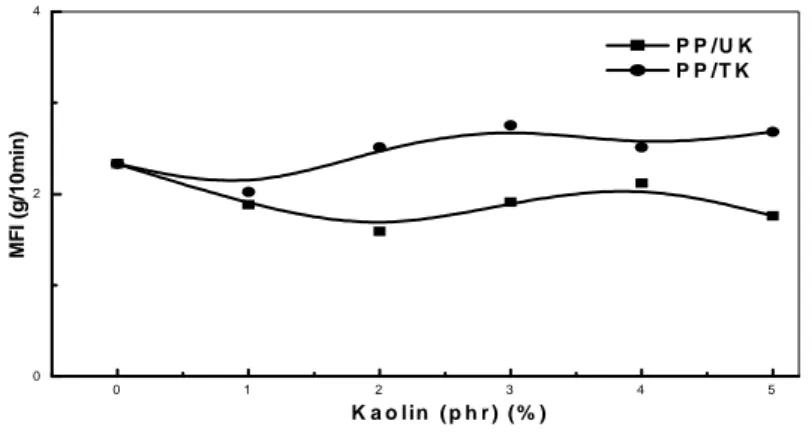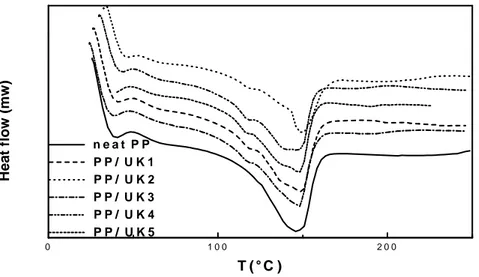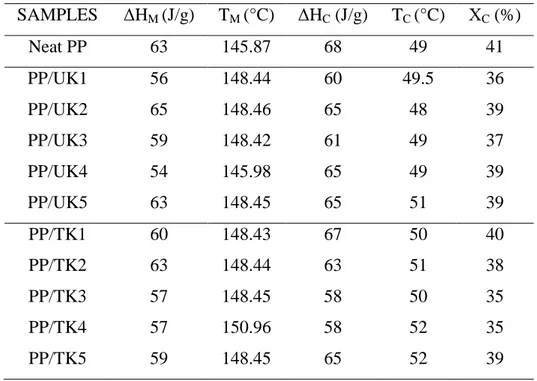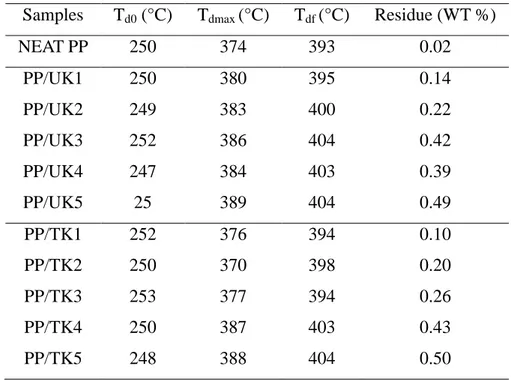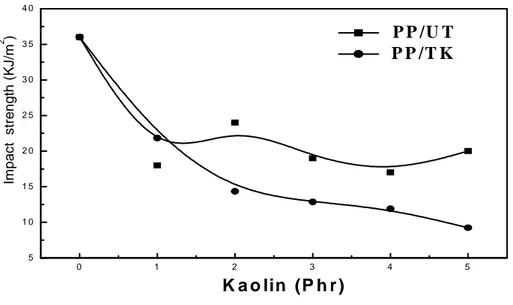Journal of Fundamental and Applied Sciences is licensed under a Creative Commons Attribution-NonCommercial 4.0 International License. Libraries Resource Directory. We are listed under Research Associations category.
POLYPROPYLENE-MODIFIED KAOLINITE COMPOSITES: EFFECT OF CHEMICAL MODIFICATION ON MECHANICAL, THERMAL AND
MORPHOLOGICAL PROPERTIES
O. Meziane*, A. Bensedira, M. Guessoum and N. Haddaoui
Laboratory: Physical-Chemistry of High Polymers (LPCHP) Department of Process Engineering, Faculty of Technology
Ferhat Abbas University – Setif 19000, Algeria
Received: 18 November 2015 / Accepted: 21 April 2016 / Published online: 01 May 2016
ABSTRACT
The intercalation of kaolinite with an ammonium salt was performed. Untreated and treated kaolinite samples were examined by X-ray diffraction (XRD). PP/kaolinite compounds were prepared by the melt intercalation method. The effects of modified clay on properties of the prepared composites were studied. The XRD results showed that the treatment with the ammonium salt caused the return to the initial state of the clay. The thermogravimetric analysis thermograms (TGA) marked an increase in thermal degradation of the composites, while the differential scanning calorimetric (DSC) results showed the decrease of the crystallization temperature and the melting point in presence of clay in the matrix owing to the fact that the filler acts as reinforcing effect. The mechanical properties of the composites exhibited important variations, the morphology of the composites was further studied using scanning electron microscopy (SEM) and showed poor dispersion of used nanoclay in PP matrix.
Keywords: polypropylene; composites; kaolinite; surface treatment; melt intercalation.
Author Correspondence, e-mail: meziane.ouahiba@yahoo.com
doi: http://dx.doi.org/10.4314/jfas.v8i2.21
1. INTRODUCTION
Composites materials and polymers composites in particular are amongst the most widely used and constitute an important class of material. A composite material is chosen wherever
Journal of Fundamental and Applied Sciences
ISSN 1112-9867
Available online at http://www.jfas.info
there is an advantage in combining the properties of two or more materials and to improve these properties, such as mechanical, thermal and barrier properties of the final polymer product.
Mineral fillers have, since the beginning, made an important contribution to the spectacular growth of thermoplastic polymers composites. This emphasis on filled polymer composites is due to a combination of factors. Addition of mineral filler can enhance the processing of the polymer at the same time as improving the balance of properties such as strength, stiffness, cost, appearance and flammability, which are the principal limitations of the bulk thermoplastics. The effects of fillers on the mechanical and other properties of the composites depend on their shape, particle and aggregate sizes, surf ace characteristics, and degree of dispersion [1, 2].
Obviously, there is a large incentive to use all the commercially and inexpensive important thermoplastic polymers, but, in volume terms, the principal markets are in PVC and polyolefins for as many applications as possible. Polypropylene is one of the most versatile commodity thermoplastics with low cost, high thermal stability and low density. The polymer is used in a wide variety of applications, including packaging, textiles, reusable containers of various types, laboratory equipment, automotive …. To improve some of its properties and thus widen its application range, blending with other polymers and/or fillers is the alternative that is usually employed in order to increase its strength, impact resistance and toughness. Among the inorganic fillers that are used to improve PP properties, clays are recognized to get several beneficial variations on stiffness, hardness, toughness and heat resistance [3, 4]. Kaolinite is a common phyllosilicate mineral, with a general chemical formulation
Al2Si2O5(OH)4. This clay has 1:1 dioctahedral structure which is composed of tetrahedral
sheets SiO4 and octatedral sheets (Al2(OH)4). Individual layered consists of both sheets which
are closely connected by hydrogen bond between surface hydroxyl groups on the octahedral side and the basal oxygen atoms on the tetrahedral side. The most reactive functional groups in kaolinite are hydroxyl groups, which are capable of taking part in many chemical reactions as well as ion exchange processes [5-7].
Because of hydrophobic properties of kaolinite and hydrophilic character of polymer (e.g., polypropylene), poor adhesion occurred between the filler surface and the matrix, in addition, achieving uniform dispersion of the fillers tended to be difficult. Therefore, the surface modification of kaolinite is necessary [6-8], it can be achieved either by the use of coupling agents, or by the insertion of small molecules agents, in the interlayer of the kaolinite, such as
O. Mezianeet al. J Fundam Appl Sci. 2016, 8(2), 494-509 496
dimethylsulfoxide (DMSO), formamide, hydrazine potassium acetate, and urea [9-10]. The separation of kaolinite layers results in particle size reducing and an increase of the specific surface area and the basal spacing of the clay which may facilitate the intercalation of polymer chains between its platelets and the composite materials exhibit remarkable improvements in materials properties compared with the virgin polymer [11].
The influence of surface treatments of kaolinite with an alkylammonium salt on the mechanical morphological and thermal properties of polypropylene (PP) was studied in present work.
2. EXPERIMENTAL 2.1. Materials
The polypropylene (PP) used in this study is a statistic copolymer grade “Moplen RP 320H”, obtained from Basell. The melt flow index (MFI) reported to be 2.30 g /10 min at 190 °C with the density of 0.9 g/cm³.
The raw kaolinite used to prepare PP/kaolinite composite, consisted of small-diameter (≤45 µm) particles that had perfect crystallization and high purity. Its chemical composition was
determined by chemical analysis (SiO2:50.44, Al2O3:28.30, CaO: 1.10, MgO: 0.50,
Fe2O3:2.29, with a loss on ignition (LOI) of 10.01). The kaolinite was modified with an
alkylammonium is a hexadecyl trimethyl ammonium chloride abbreviated as (HDTMA),
purchased from Aldrich, and having the following chemical structure: CH3 (CH2)15N
(CH3)3Cl.
2.2. Kaolinite treatments
The kaolinite used in this study was already intercalated with dimethylformamide (DMF). The resulting material was subjected to a reaction in a solution containing the ammonium salt (HDTMA) at a temperature of 80°C for 24 hours. After that, the clay was filtered and dried then stored.
2.3. Preparation of Composites
An internal mixer (Haake Rheocord) was used to prepare the required composites, respectively, PP/TK and PP/UK, with polypropylene matrix and the treated and untreated kaolinite amounts varying from 1 to 5 parts per hundred resins (phr), the mixing temperature was kept at 190°C, the rotation speed set at 30 rpm for a period of 10 minutes.
2.4. CHARACTERIZATION METHODS 2.4.1. X-ray diffraction (XRD)
XRD was used to study the modified and unmodified kaolin using XPERT diffractometer equipped with Cu-kα radiation (λ=0.154nm) at room temperature. The scans were taken in a 2 range from 4 to 30°, with 0.02° step size and the counting time of one scan 5 s.
2.4.2. Melt flow index (MFI)
Melt flow indices of polypropylene matrix and PP composites with the treated and untreated kaolinite amounts varying from 1 to 5 parts per hundred resins (phr) were measured according to ASTM D 1238 using MFI apparatus ( Melt - Indexer modèle 5), under the condition of 2.16 kg load at the temperature of 230°C.
2.4.3. Scanning electron microscopy (SEM)
It was employed to observe the morphology such as filler dispersion inside the polymeric materials and interfacial adhesion of the components. The surface of film was coated with thin layer of Au, with a SEM-coating device and then experimental using SEM with acceleration voltage of 20kV.
2.4.4. Differential scanning calorimetric (DSC)
DSC (TA Instrument) was used to study the crystallization and melting behavior. The sample were heated from ambient temperature to 250°C under nitrogen atmosphere, at heating rate of 10°C/min and kept at this temperature for 5 min before cooling down in order to assure that the materials melted uniformly and eliminating thermal history. The samples were then cooled down to room temperature at cooling rate of 10°C/min under nitrogen atmosphere.
Crystallization temperature (Tc) and melting temperature (Tm) were recorded on the
thermograms. In order to estimate the crystallinity % (χc), the following equation was used
[12]:
(%)
0×
100
∆
∆
=
c c CH
H
χ
(1)Where, ∆Hc is the crystallization melting enthalpy of the sample analyzed [J/g], and
0
c
H
∆ is
reference value that represents the crystallization melting enthalpy for 100% crystalline
Polypropylene (∆Hc0 is 165 J/g) was used [13].
2.4.5. Thermogravimetric analysis (TGA)
The thermal characteristics of the samples was determined by thermal gravimetric analysis (TGA) using a TGA Q500 apparatus with a heating rates of 20◦C/min in air The isothermal
O. Mezianeet al. J Fundam Appl Sci. 2016, 8(2), 494-509 498
degradation experiment was performed from 20 to 550°C. From thermograms giving the variations of the weight loss derivative as a function of temperature, we estimated the
temperatures at which starts and finishes the degradation process Td0 and Tdf, respectively, as
well as, the temperature at the maximum weight loss and the residual mass, Tdmax and Mres,
respectively.
2.4.6. Mechanical properties
Notched Izod impact strengths were measured on compressed samples according to the norm ASTM D256, using a Resil Impactor pendulum instrument to characterize the tensile characteristics of the hompolymer and its composites, namely, the stress and the elongation at
yielding and at break ( σy and εy) and (σr and εr), respectively, measurements were performed
according to the norm ASTM D638, at a cross-head speed of 30 mm/min on dumbbell samples using a Zwick Material prufung 1445.
3. RESULTS AND DISCUSSION 3.1. XRD analysis
The XRD was used to observe intercalation process into kaolinite. ‘Figure1’ (curve b), depicting the XRD pattern of the kaolinite treated with the alkylammonium salt in aqueous solution, shows that the treatment does not produce any detectable structural changes on the
interlayer spacing of the clay, with a few decrease in intensity of d001 basal diffraction of
kaolinite.
So, it is clear that the ammonium salt molecules interacted with the kaolinite hydroxyls groups involved at the surface of the clay particles and not with those situated in the interlayer space. 0 3 0 6 0 9 0 0 8 0 0 1 6 0 0 b : k a o l i n / H D T M A a : n e a t k a o l i n (I n te n si ty ) (a .u ) 2 Θ ( ° )
3.2. Melt flow index (MFI)
Figure 2 represents the variations of melt flow index (MFI) of PP/UK and PP/TK composites. MFI has marginal reduction of 2.33 to 1.76g/10 min of PP/UK and of 2.33 to 2.68 for PP/TK, respectively, due to addition of untreated and treated kaolinite. And according to the figure, we observe a slight variation of the values of the index of fluidity compared to that of the matrix. This can be due to the low content of kaolin and the formation of agglomerates within the matrix, in consequence of the bad dispersion of the particles of the load. These agglomerates can prevent the flow of polymer. Also, according to the figure 2 and table 1, it is noted that the MFI values of PP/TK are higher than those of the PP/UK composites, this increase can be due to the treatment of used clay, so, the use of alkylammonium salts for the treatment of kaolinite facilitates the flow of the chains of the matrix PP. The MFI values of PP and its composites are shown in table 1.
0 1 2 3 4 5 0 2 4 M F I (g /1 0 m in ) K a o l in ( p h r ) ( % ) P P /U K P P /T K
Fig.2. PP composites melt flow index variations as a function of treated and untreated kaolin concentration
Table 1. MFI values of PP and its composites
Kaolin (phr) MFI (g/ 10min)
PP/UK PP/TK 0 2.33 2.33 1 1.88 2.02 2 1.59 2.51 3 1.91 2.75 4 2.12 2.51 5 1.76 2.68
O. Mezianeet al.
3.3. Morphology
The dispersion of clay in polypropylene was evaluated by scanning
(SEM). Figure 3 is the SEM micrograph of PP/UK and PP/TK filled with 4 phr, it shows that the untreated kaolinite (UK) and
throughout matrix; However, a deeper investigation, spec
aggregates for all composites, suggests a swollen lamellar structure within themselves, the presence of large and small agglomerates and poor adhesion to the polymer. It is very difficult to estimate the size of the
dispersed in matrix. The size of the aggregates is, therefore, strongly dependent on orientation of particles. However, the size of aggregates in PP/UK is larger than the size of aggregates in PP/TK. However, utilization of the treatment kaolinite improved dispersion and decrease the size of aggregation.
Fig.3. SEM micrographs of PP composites filled with 4 a) Treated kaolinite b
J Fundam Appl Sci. 2016, 8(2), 494-509
The dispersion of clay in polypropylene was evaluated by scanning electron microscopy 3 is the SEM micrograph of PP/UK and PP/TK filled with 4 phr, it shows that kaolinite (UK) and treated kaolinite (TK) is not evenly dispersed in the However, a deeper investigation, specifically performed on filler aggregates for all composites, suggests a swollen lamellar structure within themselves, the presence of large and small agglomerates and poor adhesion to the polymer. It is very difficult to estimate the size of the aggregates because they are non-isometric and randomly dispersed in matrix. The size of the aggregates is, therefore, strongly dependent on orientation of particles. However, the size of aggregates in PP/UK is larger than the size of aggregates in owever, utilization of the treatment kaolinite improved dispersion and decrease the
-a- -b
SEM micrographs of PP composites filled with 4 phr of: a) Treated kaolinite b) Untreated kaolinite at different magnitudes
500
electron microscopy 3 is the SEM micrograph of PP/UK and PP/TK filled with 4 phr, it shows that kaolinite (TK) is not evenly dispersed in the ifically performed on filler aggregates for all composites, suggests a swollen lamellar structure within themselves, with the presence of large and small agglomerates and poor adhesion to the polymer. It is very isometric and randomly dispersed in matrix. The size of the aggregates is, therefore, strongly dependent on orientation of particles. However, the size of aggregates in PP/UK is larger than the size of aggregates in owever, utilization of the treatment kaolinite improved dispersion and decrease the
phr of: magnitudes
3.4. Melting and Crystallization Behaviors
Figures 4 and 5 compare the DSC cooling thermograms of neat PP with its various composites. In (Figures 4), the effects of adding unmodified kaolin on the crystallization of PP are evident.
The crystallization peak temperature Tc (temperature at the exotherm maximum) of PP was
slightly shifted as kaolin is added. The little variation in the crystallization temperature after introduction of the filler means that higher undercooling of the melt is necessary for the
crystallization to occur14; we believe that the reason of this behavior is the strong influence of
the kaolinite on the chain dynamics. Although fillers usually act as nucleation centers [15], the crystallization in the present system is slowed down as a result of lower chain mobility.
0 1 0 0 2 0 0 H e a t fl o w ( m w ) T ( ° C ) n e a t P P P P / U K 1 P P / U K 2 P P / U K 3 P P / U K 4 P P / U K 5
Fig.4. DSC thermograms of PP/untreated kaolin
Figure 5 depicts the DSC cooling thermograms of neat PP and its ammonium modified kaolin composites. The crystallization retarding effect of the filler is still observed, but it is more obvious for the clay loadings of 4 and 5 phr, so the shifting of the crystallization temperature increases proportionally to the clay concentration. When comparing the thermograms of the composites including the three first modified kaolin loadings (1, 2, and 3 phr), with those of the composites containing the equivalent rates of the unmodified clay, we notice that the
values of Tc are slightly lower to the matrix ones but sufficiently higher to those of the
composites PP/unmodified kaolin. This fact can merely be linked to the treatment and to the interactions between the kaolinite modified surface and PP chains. Thus, the combined effect of the clay and of the interactions clay/matrix contributes to get an enhanced PP chains
O. Mezianeet al. J Fundam Appl Sci. 2016, 8(2), 494-509 502
mobility and consequently a faster crystallization rate and higher crystallization temperatures, relatively to untreated kaolin composites.
0 1 0 0 2 0 0 H ea t fl o w ( m w ) T (° C ) n e a t P P P P /T K 1 P P / T K 2 P P / T K 3 P P / T K 4 P P / T K 5
Fig.5. DSC thermograms PP/treated kaolin
The melting peak temperatures Tm of the untreated and ammonium treated kaolin composites
vary trivially with respect to that of neat PP. This result suggests that the addition of small kaolin concentrations and its treatment did not affect the structure and the stability of the formed PP crystals.
These results indicate that the incorporation and the modification of the filler apparently affect the PP crystallization rate, but influence the PP crystallinity only slightly, as it is reported in the Table 2.
DSC results show no significant differences between pure PP and composites (Table 2). We
expected nanoclay act as a nucleating agent and enhance crystallization temperature (Tc).
Nevertheless, the crystallization capability of nanoclay composites will not be improved if the filler network plays a role to restrict the movement of molecular chains. There are no
significant changes in Tm and Xc between all samples. Therefore, most of nanoparticles are
placed in amorphous phase. Additionally, the crystallization heat ∆Hc varied in significantly
Table 2. DSC results for Polypropylene and its composites filled with treated and untreated kaolinite SAMPLES ∆HM (J/g) TM (°C) ∆HC (J/g) TC (°C) ΧC (%) Neat PP 63 145.87 68 49 41 PP/UK1 PP/UK2 PP/UK3 PP/UK4 PP/UK5 56 65 59 54 63 148.44 148.46 148.42 145.98 148.45 60 65 61 65 65 49.5 48 49 49 51 36 39 37 39 39 PP/TK1 PP/TK2 PP/TK3 PP/TK4 PP/TK5 60 63 57 57 59 148.43 148.44 148.45 150.96 148.45 67 63 58 58 65 50 51 50 52 52 40 38 35 35 39 3.5. Thermal degradation
The effect of the nanofiller presence on the thermal stability of the composites was studied by means of thermogravimetry experiments. Figures 6 and 7 report the TGA curves, obtained under air atmosphere, of PP samples and composites which degradation characteristics are reported in the (Table 2).
The degradation of pure polypropylenes takes place in one stage from 250 to 393°C with approximately no residual mass.
The PP/untreated kaolin composites showed almost an identical thermal stability and as the PP matrix, they are decomposed on only one stage. All the composites started degradation at 250 °C, however; a noticeable increase is observed on the value of the temperature at which
the degradation is achieved Tdf. For example, the composite including 5 phr of kaolin begins
to degrade at 250 ◦C and finished at 405 ◦C, with a residual mass around 5.5 %, which is
approximately the clay loading in the composite. Tdmax exhibit the same variations as Tdf
because it increases when the kaolin concentration increases. Indeed, Tdmax varies from 374 ◦C
for neat PP to 389 ◦C for the formulation including 5phr of kaolinite. These observations
suggest that the addition of small amounts of the filler enhances noticeably the thermal stability of the whole material [16].
O. Mezianeet al. J Fundam Appl Sci. 2016, 8(2), 494-509 504
The thermal stability of the PP/modified kaolin composites, exhibited a similar trend as the
above ones. All the formulations started degradation around 250◦C and finishes with a residual
mass equivalent to the clay loading in the composites. Tdf and Tdmax showed an enhancement
relative to the matrix, but no variations were noticed when compared to the composites with unmodified clay. So, the thermal stability enhancement is mainly due to the clay.
0 2 0 0 4 0 0 0 3 0 W e ig h t lo s s ( m g ) T e m p e r a t u r e ( ° C ) n e a t p p P P U K 1 P P U K 2 P P U K 3 P P U K 4 P P U K 5
Fig.6. TGA thermograms of neat PP and UK/PP composites
0 2 0 0 4 0 0 0 3 0 W e ig h t lo s s ( m g ) T e m p e r a t u r e ( ° C ) n e a t p p P P /T K 1 P P /T K 2 P P /T K 3 P P /T K 4 P P /T K 5
Table 3. TGA data for PP samples and its composites filled with treated and untreated kaolinite
Samples Td0 (°C) Tdmax (°C) Tdf (°C) Residue (WT %)
NEAT PP 250 374 393 0.02 PP/UK1 PP/UK2 PP/UK3 PP/UK4 PP/UK5 250 249 252 247 25 380 383 386 384 389 395 400 404 403 404 0.14 0.22 0.42 0.39 0.49 PP/TK1 PP/TK2 PP/TK3 PP/TK4 PP/TK5 252 250 253 250 248 376 370 377 387 388 394 398 394 403 404 0.10 0.20 0.26 0.43 0.50
3.6. Composites Mechanical properties 3.6.1. Composites Impact Strength
The Izod impact strength variations of the PP composites notched samples filled with modified and unmodified kaolin are illustrated by Figure 8.
It appears that kaolinite incorporation to the thermoplastic matrix causes a marked decrease of its impact strength. This result is explained by the fact that the introduction of the mineral filler engenders an increase of rigidity and causes a high local stress concentration at the inter face filler/matrix, attributed especially to aggregates formation which weakens the strength of all the material. Because of the prominent dominance of these effects, the ammonium kaolinite treatment effect is not apparent.
O. Mezianeet al. J Fundam Appl Sci. 2016, 8(2), 494-509 506 0 1 2 3 4 5 5 1 0 1 5 2 0 2 5 3 0 3 5 4 0 Im p a c t s tr e n g th ( K J /m 2 ) K a o lin (P h r ) P P /U T P P /T K
Fig.8. PP composites notched Izod impact strength variations as a function of treated and untreated kaolin concentration
3.6.2. Composites Tensile Properties
Figures 9 and 10 depict the tensile characteristics variations for the composites prepared with unmodified kaolin and with kaolin treated with the alkylammonium salt. Thus, it appears from the Figure 9 that the yielding stress and strain values are slightly affected by kaolinite treatment and concentration.
Figure 10 illustrates the variations of the stress and the strain at break as function of the filler rate for the composites with treated and untreated kaolin. The behavior at break of the composites has been markedly affected by the incorporation of the mineral filler. Thus, the strain noticeable decrease occur red from 600% for the nonfilled PP to a value of 60%for the composites with 5 phr of untreated kaolin and to 27% for that containing the same concentration of the filler treated with the alkylammonium salt. The decrease of the strain at break a t this filler loading might be due to the decreased deformability at the interface the filler/matrix.
0 1 2 3 4 5 10 15 20 25 PP/ UK PP/ TK y ie ld in g s tr a in ( % ) y ie ld in g s tr e s s ( M P a ) KAOLIN (phr) 10 15 20 25
Fig.9. PP composites yielding stress and strain variations as a function of treated and untreated kaolin concentration
0 1 2 3 4 5 0 5 10 15 20 25 30 s tr a in a t b re a k ( % ) s tr e s s a t b re a k ( M P a ) Kaolin (phr) P P /U K PP/TK 0 5 10 15 20 25 30
Fig.10. PP composites breaking stress and strain variations as a function of treated and untreated kaolin concentration
4. CONCLUSION
Polypropylene/ untreated and treated kaolinite composites have been prepared via direct melt intercalation in an internal mixer. The effect of the untreated and treated kaolinite by alkylammonium salt on the morphology, thermal and mechanical properties of pure polypropylene was investigated.
O. Mezianeet al. J Fundam Appl Sci. 2016, 8(2), 494-509 508
Also, the clay samples were XRD to confirm the organophilic nature after modification. It confirmed that the 001 reflection of the clay was not affected by the treatment, which states that the inter actions concerned essentially the superficial groups of kaolinite via an adsorption process. MFI index results of composites show a slight variation of the values of the index of fluidity compared to that of the matrix. And due to the treatment of kaolinite with HDTMA, the MFI values of PP/TK are higher than those of the PP/UK composites.
SEM micrographs show poor dispersion of used nanoclay in polypropylene matrix.
DSC results show that thermal properties of the polypropylene has not been effected much by addition of treated and untreated kaolinite and there was no significant changes in on the
crystallinity and on the melting temperature of the matrix Xc, Tc and Tm, Also, the TGA results
confirmed a slight enhancement of the thermal stability of the composites relative to the neat matrix and the bonding of alkylammonium to its groups.
The mechanical characterization showed the decease of the PP/kaolin composites impact strength due to aggregates formation and to the poor adhesion between the filler surface and the matrix. In the opposite, small variations were observed on the tensile characteristics.
5. ACKNOWLEDGEMENTS
I want to thank everyone who helped me to make this modest work, starting with the promoter with special tips as well as people working in laboratories where I realized the tests.
6. REFERENCES
[1] Jo B W, Park S K, and Kim D K. Mechanical Properties of Nano-MMT Reinforced
Polymer Composite and Polymer Concrete. Construction and Building Materials., 2008,22, 14-20.
[2] Wang Y, Wang J J. Shear yield behavior of calcium carbonate-filled polypropylene,”
Polymer Engineering and Science., 1999, 39(1), 190-198.
[3] Lee H, S Kim, Song J E, and Kim H. Thermal Properties of Maleated
Polypropylene/Layered Silicate Nanocomposites, International Journal of
Thermoplastics., 2004, 25, 1585-1595.
[4] Rimdusit S, Smittakorn W, Jittarom S and Tiptipakorn S. Highly Filled Polypropylene
Rubber Wood Flour Composites, Engineering Journal.,2011, 15,17-30.
[5] Duca J, Kaolin. In. Functional Fillers for Plastics, (Ed) Wiley-VCH, Verlag, New York
[6] Frost R L, Kristof J, Schmidt J, and Kloprogge J T. Raman Spectroscopy of Potassium Acetate-Intercalated Kaolinites at Liquid Nitrogen Temperature, Spectrochimica Acta., 2001, 57, 603-609.
[7] Frost R L, Kristof J Rintoul, L, and Kloprogge J T. Raman Spectroscopy of Urea and
Urea-Intercalated Kaolinites at 77K, Spectrochimica Acta., 2000, 56, 1681-1691.
[8] Frost R L, Kristof J, Horvath E, and Kloprogge J T. Effect of Water on the
Formamide-Intercalation of Kaolinite, Spectrochimica Acta., 2000, 56, 1711-1729.
[9] Deng Y, Dixon J B, and White G N. Molecular Configurations and Orientations of
Hydrazine Between Structural Layers of Kaolinite, Journal of Colloid and Interface Science., 2003, 257, 208-227.
[10]Janek M, Emmerich K, Heissler S, and Nüesch R. Thermal Induced Grafting Reactions of
Ethylene Glycol and Glycerol Intercalates of Kaolinite, American Chemical Society., 2007, 19, 684-693.
[11]Olejnik S, Posner A, and Quirk J P. the Intercalation of Polar Organic Compounds into
Kaolinite, Clay Minerals., 1970, 8, 421-434.
[12]Letaif S, Elbokl T A, and Detellier C. Reactivity of Ionic Liquids With Kaolinite: Melt
Intersalation of Ethyl Pyridinium Chloride in an Urea-Kaolinite Pre-intercalate, Journal of Colloid and Interface Science., 2006, 302, 254-258.
[13]Roses A L, Marsili E, Nieuwlaar E, and Patel M K Environmental and Cost Assessment
of a Polypropylene Nanocomposite, Journal of polymer environnement., 2007, 15, 212-226.
[14]Luyt A S, Dramicanin M D, Antic Z, and Djokovic V. Morphology, mechanical and
thermal properties of composites of polypropylene and nanostructured wollastonite filler, Polymer Testing., 2009, 28( 3), 348-356.
[15]Njuguna J, Pielichowski K, and Desai S. Nanofiller-reinforced polymer nanocomposites
Polymers for Advanced Technologies., 2008, 19 (8), 947- 959.
[16]Lopez-Quintanilla M L, Sanchez-Valdes S, Devalle L F R, and Medellin-Rodriguez F J.
Effect of some compatibilizing agents on clay dispersion of polypropylene-clay nanocomposites, Journal of Applied Polymer Science., 2006, 100 (6), 4748-4756.
How to cite this article:
Meziane O, Bensedira A, Guessoum M and Haddaoui N. Polypropylene-modified kaolinite composites: effect of chemical modification on mechanical, thermal and morphological properties. J. Fundam. Appl. Sci., 2016, 8(2), 494-509.
